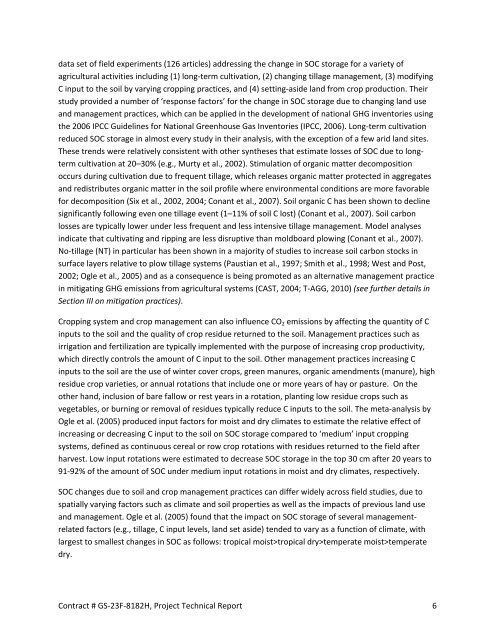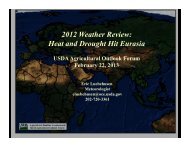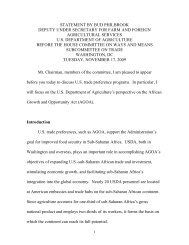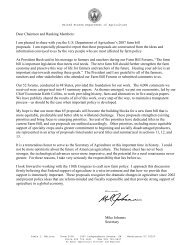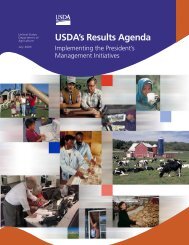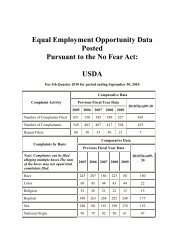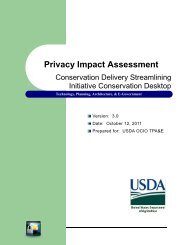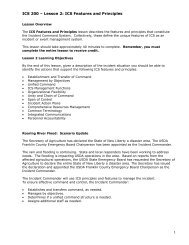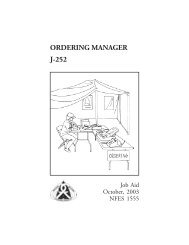Greenhouse Gas Emissions from U.S. Agriculture and Forestry: A ...
Greenhouse Gas Emissions from U.S. Agriculture and Forestry: A ...
Greenhouse Gas Emissions from U.S. Agriculture and Forestry: A ...
You also want an ePaper? Increase the reach of your titles
YUMPU automatically turns print PDFs into web optimized ePapers that Google loves.
data set of field experiments (126 articles) addressing the change in SOC storage for a variety of<br />
agricultural activities including (1) long‐term cultivation, (2) changing tillage management, (3) modifying<br />
C input to the soil by varying cropping practices, <strong>and</strong> (4) setting‐aside l<strong>and</strong> <strong>from</strong> crop production. Their<br />
study provided a number of ‘response factors’ for the change in SOC storage due to changing l<strong>and</strong> use<br />
<strong>and</strong> management practices, which can be applied in the development of national GHG inventories using<br />
the 2006 IPCC Guidelines for National <strong>Greenhouse</strong> <strong>Gas</strong> Inventories (IPCC, 2006). Long‐term cultivation<br />
reduced SOC storage in almost every study in their analysis, with the exception of a few arid l<strong>and</strong> sites.<br />
These trends were relatively consistent with other syntheses that estimate losses of SOC due to long‐<br />
term cultivation at 20–30% (e.g., Murty et al., 2002). Stimulation of organic matter decomposition<br />
occurs during cultivation due to frequent tillage, which releases organic matter protected in aggregates<br />
<strong>and</strong> redistributes organic matter in the soil profile where environmental conditions are more favorable<br />
for decomposition (Six et al., 2002, 2004; Conant et al., 2007). Soil organic C has been shown to decline<br />
significantly following even one tillage event (1–11% of soil C lost) (Conant et al., 2007). Soil carbon<br />
losses are typically lower under less frequent <strong>and</strong> less intensive tillage management. Model analyses<br />
indicate that cultivating <strong>and</strong> ripping are less disruptive than moldboard plowing (Conant et al., 2007).<br />
No‐tillage (NT) in particular has been shown in a majority of studies to increase soil carbon stocks in<br />
surface layers relative to plow tillage systems (Paustian et al., 1997; Smith et al., 1998; West <strong>and</strong> Post,<br />
2002; Ogle et al., 2005) <strong>and</strong> as a consequence is being promoted as an alternative management practice<br />
in mitigating GHG emissions <strong>from</strong> agricultural systems (CAST, 2004; T‐AGG, 2010) (see further details in<br />
Section III on mitigation practices).<br />
Cropping system <strong>and</strong> crop management can also influence CO2 emissions by affecting the quantity of C<br />
inputs to the soil <strong>and</strong> the quality of crop residue returned to the soil. Management practices such as<br />
irrigation <strong>and</strong> fertilization are typically implemented with the purpose of increasing crop productivity,<br />
which directly controls the amount of C input to the soil. Other management practices increasing C<br />
inputs to the soil are the use of winter cover crops, green manures, organic amendments (manure), high<br />
residue crop varieties, or annual rotations that include one or more years of hay or pasture. On the<br />
other h<strong>and</strong>, inclusion of bare fallow or rest years in a rotation, planting low residue crops such as<br />
vegetables, or burning or removal of residues typically reduce C inputs to the soil. The meta‐analysis by<br />
Ogle et al. (2005) produced input factors for moist <strong>and</strong> dry climates to estimate the relative effect of<br />
increasing or decreasing C input to the soil on SOC storage compared to ‘medium’ input cropping<br />
systems, defined as continuous cereal or row crop rotations with residues returned to the field after<br />
harvest. Low input rotations were estimated to decrease SOC storage in the top 30 cm after 20 years to<br />
91‐92% of the amount of SOC under medium input rotations in moist <strong>and</strong> dry climates, respectively.<br />
SOC changes due to soil <strong>and</strong> crop management practices can differ widely across field studies, due to<br />
spatially varying factors such as climate <strong>and</strong> soil properties as well as the impacts of previous l<strong>and</strong> use<br />
<strong>and</strong> management. Ogle et al. (2005) found that the impact on SOC storage of several management‐<br />
related factors (e.g., tillage, C input levels, l<strong>and</strong> set aside) tended to vary as a function of climate, with<br />
largest to smallest changes in SOC as follows: tropical moist>tropical dry>temperate moist>temperate<br />
dry.<br />
Contract # GS‐23F‐8182H, Project Technical Report 6


